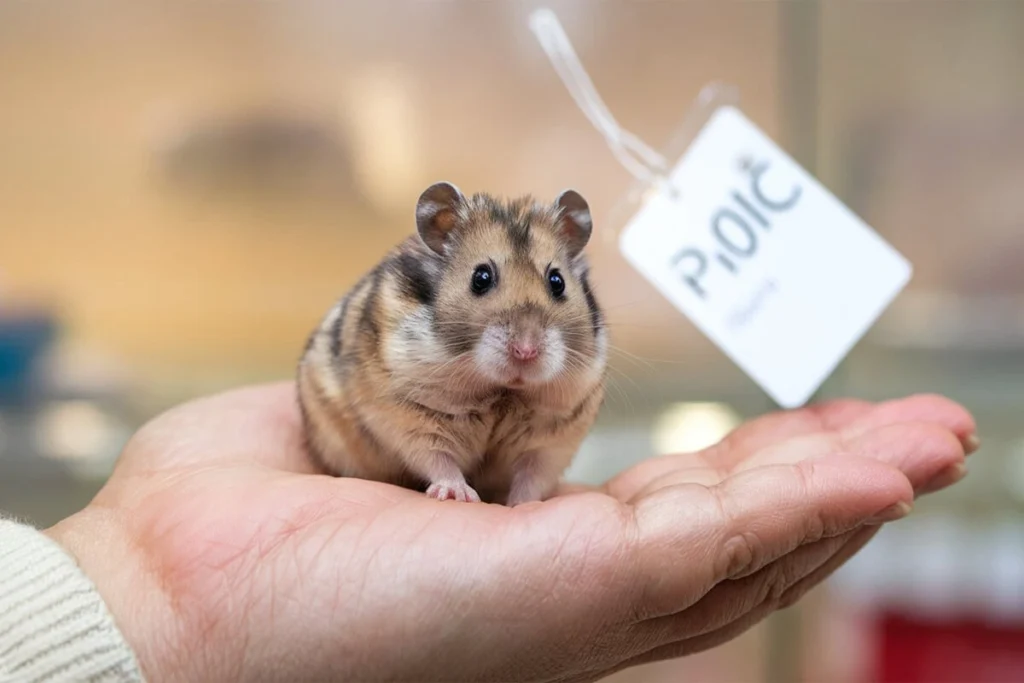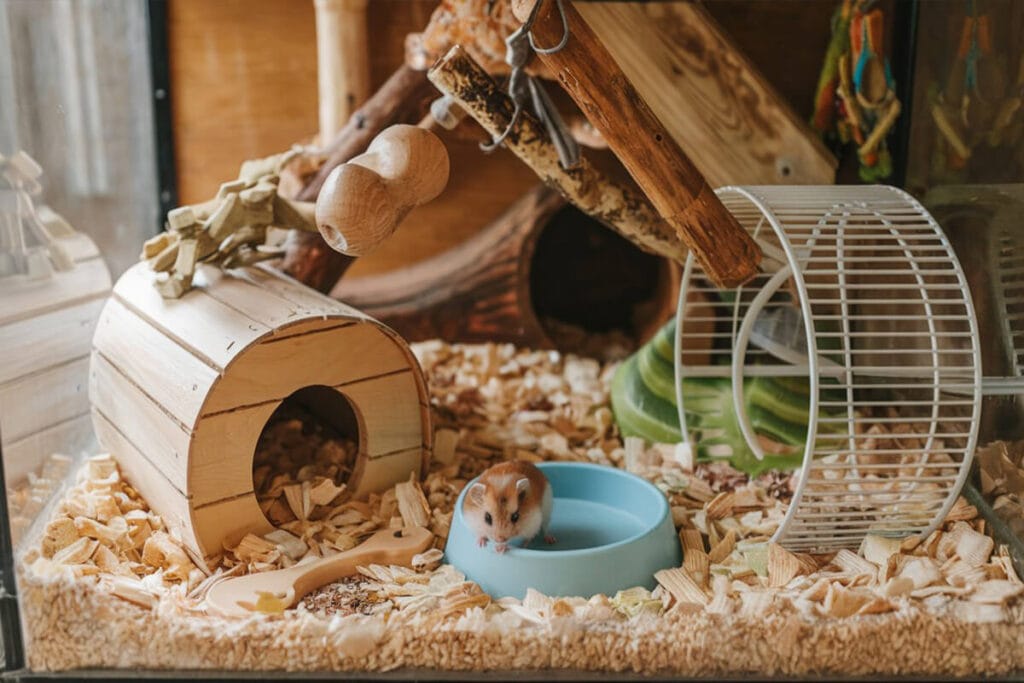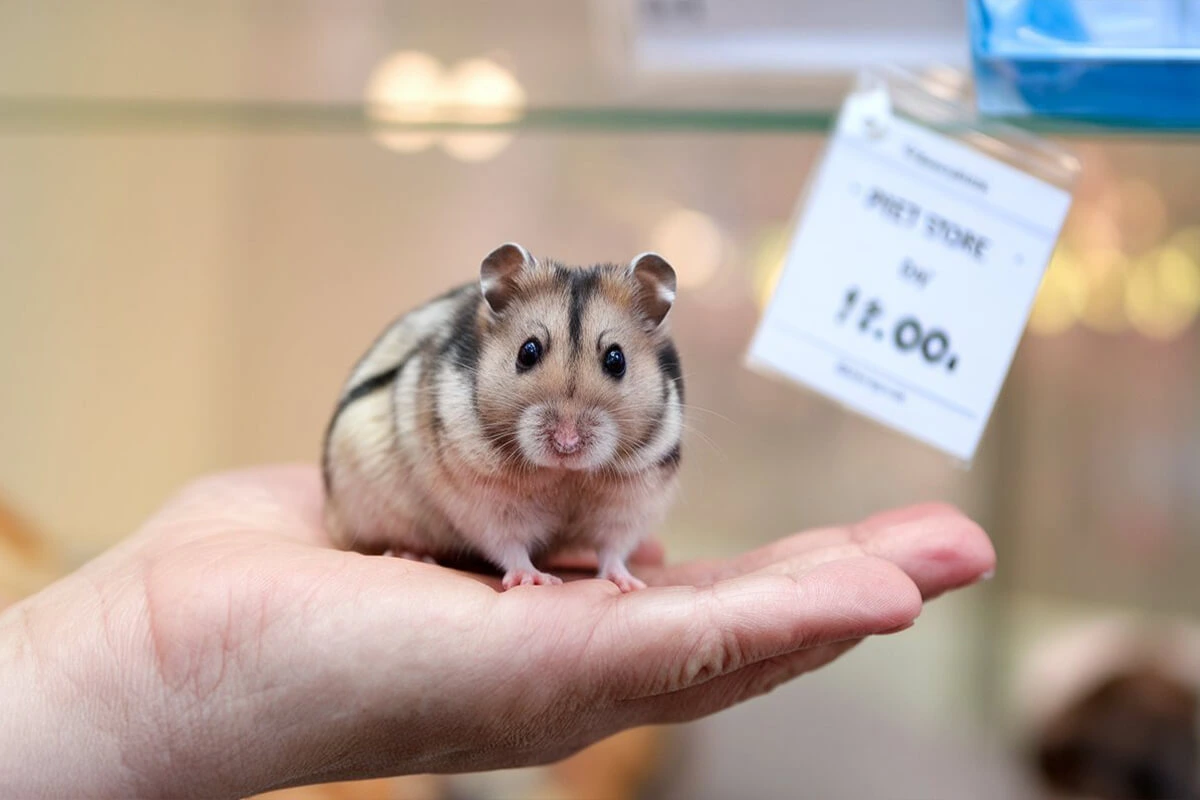Chinese dwarf hamsters make adorable and low-maintenance pets, but understanding the Chinese dwarf hamster price is essential before bringing one home. The cost of these tiny creatures varies based on several factors, including where you buy them, their age, and their overall health. Whether you purchase from a pet store, adopt from a shelter, or find a breeder, knowing the Chinese dwarf hamster price helps you budget for your new furry friend.
Buying a hamster isn’t just about the upfront cost. Pet owners must consider additional expenses such as cages, bedding, food, and toys. These essential supplies ensure the hamster stays comfortable and healthy. Some pet owners also invest in accessories like tunnels, wheels, and climbing structures to keep their hamster active and entertained. Factoring in these ongoing expenses is crucial when determining the Chinese dwarf hamster price in the long run.
Price differences often depend on where you choose to buy your hamster. Large pet stores like PetSmart and Petco typically offer Chinese dwarf hamsters at standard retail prices, while private breeders may charge more for well-bred, healthier hamsters. Exotic pet shops sometimes sell rare color variations at a higher price. If you’re looking for a budget-friendly option, adopting from an animal shelter or rescue center could lower the Chinese dwarf hamster price while giving a pet a second chance at a loving home.
This guide breaks down everything you need to know about the Chinese dwarf hamster price, where to buy one, and how to save money on supplies. By the end, you’ll have a clear understanding of how much to budget for your new pet and the best ways to provide a happy, healthy home without overspending.
What’s The Chinese Dwarf Hamster Price Point?
Average Price Range
The Chinese dwarf hamster price typically falls between $10 and $25, depending on where you buy it. Large chain pet stores like PetSmart and Petco often sell Chinese dwarf hamsters at the lower end of this range, usually around $10 to $15. Independent exotic pet shops and hamster breeders may charge more, sometimes up to $25 or even $30, especially if the hamster has unique markings or comes from a strong genetic line. The Chinese dwarf hamster price from breeders can be higher due to selective breeding for better health and temperament.
Adopting from an animal shelter or rescue center can be a cost-effective way to bring home a hamster. The Chinese dwarf hamster price through adoption usually ranges between $5 and $15, and these fees often include initial veterinary care, making adoption both a budget-friendly and responsible choice. Some rescues even waive adoption fees during special events, further lowering the Chinese dwarf hamster price for potential pet owners.

Understanding the Chinese dwarf hamster price helps new owners make an informed decision about where to buy their pet and how to budget for ongoing care. Whether purchasing from a pet store, breeder, or adopting from a shelter, knowing the price range ensures a smooth and affordable start to hamster ownership.
Factors Affecting the Price
Several factors influence the price of a Chinese dwarf hamster, including:
- Source of Purchase – Prices vary depending on whether you buy from a pet store, breeder, exotic pet shop, or adopt from a shelter. Pet stores offer the lowest prices, while breeders and specialty shops charge more for healthier or selectively bred hamsters.
- Age and Health – Young hamsters, usually 4 to 8 weeks old, tend to be cheaper, as they are easier to train and bond with. Older hamsters might cost less because they have a shorter lifespan left, but some shelters might charge more for those that have received vaccinations or health check-ups.
- Rarity of Color or Markings – Standard Chinese dwarf hamsters have a grayish-brown coat with a dark stripe along their back, but rare variations (like lighter or darker fur shades) might increase the price. Some breeders charge extra for unusual patterns or markings.
- Location and Demand – Prices fluctuate based on geographical location. In areas where exotic pets are popular, hamsters might be priced higher due to increased demand. Smaller towns with fewer pet stores may also see higher prices because of limited availability.
- Breeder Reputation – Buying from a reputable breeder can be more expensive because they focus on providing healthier hamsters with strong genetics. While this increases the initial cost, it may save money in the long run by reducing vet visits.
Additional Initial Costs
Besides the price of the hamster itself, new owners need to budget for essential supplies. The cost of setting up a proper environment for your hamster often exceeds the price of the pet. Here’s what to expect:
- Hamster Cage ($30 – $100) – A spacious, well-ventilated cage is essential. Wire cages with deep plastic bases or glass tanks with mesh tops are popular choices. Avoid small cages that don’t provide enough space for exercise.
- Bedding and Nesting Material ($10 – $20 per month) – Safe bedding materials like aspen shavings, paper-based bedding, or hemp ensure comfort and absorb moisture. Avoid cedar or pine, as they can cause respiratory problems.
- Food and Treats ($10 – $20 per month) – A balanced hamster diet includes high-quality pellets, fresh vegetables, and occasional treats like dried fruits, mealworms, or nuts. Investing in good food helps keep your hamster healthy.
- Exercise Wheel and Toys ($10 – $30) – Hamsters need plenty of stimulation. A solid-surface wheel (not wire) allows safe running, and tunnels, chew toys, and climbing structures keep them entertained.
- Food and Water Dishes or Bottles ($5 – $15) – Choose sturdy, chew-proof bowls and a leak-proof water bottle to ensure your hamster stays hydrated.
- Hiding Spots and Accessories ($10 – $30) – Hamsters feel safer with small hideouts, wooden houses, or tunnels where they can rest or store food.
By the time you purchase the hamster and all the necessary supplies, the total initial cost can range from $80 to $200. Planning ahead and budgeting for these expenses ensures your hamster starts life in a comfortable, stress-free environment.
Where to Buy a Chinese Dwarf Hamster
Finding the right place to buy a Chinese dwarf hamster affects not only the price but also the hamster’s health, temperament, and overall well-being. You can purchase a hamster from pet stores, exotic pet shops, private breeders, or adopt from animal shelters. Each option has its pros and cons, so it’s important to consider where you’ll get the healthiest hamster for the best price.

Pet Stores (PetSmart, Petco, etc.)
Large pet store chains like PetSmart and Petco offer a convenient and affordable option for buying a Chinese dwarf hamster. These stores usually sell hamsters for $10 to $20, depending on location and availability.
Pros of Buying from Pet Stores:
- Lower Prices – PetSmart and Petco often sell hamsters at a standard retail price, making them one of the cheapest options.
- Convenient and Accessible – You can walk into a store, see the available hamsters, and purchase one immediately.
- One-Stop Shopping – You can buy cages, bedding, food, and accessories at the same place.
Cons of Buying from Pet Stores:
- Limited Health Information – Many large pet stores buy hamsters from mass breeders, so their health and genetics may not be as strong as those from ethical breeders.
- Possible Mistreatment – Some stores keep hamsters in small enclosures with little enrichment, leading to stress and potential health issues.
- Minimal Handling – Store employees don’t always handle hamsters regularly, so some may be skittish or difficult to tame.
Pro Tip: If you choose to buy from a pet store, visit during less busy hours to observe the hamsters. Look for one that is active, alert, and has clean fur and bright eyes. Avoid any hamster that appears lethargic or has signs of illness, like wet fur around the tail (a symptom of wet tail disease).
Exotic Pet Shops & Breeders
Some pet owners prefer to buy from specialty pet stores or private breeders because they focus more on hamster health and care. Prices at exotic pet shops and from reputable breeders range from $20 to $50, depending on the hamster’s lineage and rarity.
Pros of Buying from Exotic Pet Shops & Breeders:
- Healthier Hamsters – Ethical breeders and specialty shops prioritize the hamster’s well-being, reducing the risk of genetic issues or diseases.
- Better Socialization – Many breeders handle their hamsters from birth, making them friendlier and easier to tame.
- More Variety – Some breeders offer rare color variations or specific traits that standard pet stores don’t carry.
Cons of Buying from Exotic Pet Shops & Breeders:
- Higher Cost – Prices are often double or triple what pet stores charge.
- Availability May Be Limited – Breeders and specialty shops don’t always have hamsters ready for purchase, so you may need to join a waitlist.
- Location Issues – Finding a good breeder near you may be difficult, and shipping small pets can be stressful for them.
Pro Tip: If you buy from a breeder, ask for health records and lineage information. Ethical breeders will be transparent about where their hamsters come from and how they raise them. Always visit the breeder’s home or facility to check for clean, humane conditions.
Animal Shelters & Rescue Centers
Adopting a Chinese dwarf hamster from a rescue center or animal shelter provides a second chance for a pet in need. Adoption fees usually range between $5 and $15, making this the most budget-friendly and ethical option.
Pros of Adopting from a Shelter:
- Lower Cost – Adoption fees cover basic veterinary care, making this a more affordable option.
- Health Screenings Included – Many shelters examine and treat hamsters before putting them up for adoption.
- Supporting a Good Cause – Adopting helps reduce the demand for mass breeding and provides a loving home for an abandoned hamster.
Cons of Adopting from a Shelter:
- Limited Availability – Shelters don’t always have Chinese dwarf hamsters in stock, so you may need to check regularly.
- Unknown Background – Some rescue hamsters may have had traumatic experiences or behavioral issues, requiring extra patience.
- Older Hamsters – Many shelter hamsters are older, meaning they may have a shorter lifespan left compared to buying a baby hamster.
Pro Tip: Check websites like Petfinder or visit local shelters to see if any hamsters are available for adoption. If you find one, ask about its health history, age, and temperament before bringing it home.
Budget-Friendly Tips for Buying a Chinese Dwarf Hamster
Owning a Chinese dwarf hamster doesn’t have to be expensive. By knowing where to look and how to shop smartly, you can find great deals on both the hamster itself and the supplies needed for its care. Whether you choose to buy from a pet store, adopt from a shelter, or purchase from a breeder, understanding how to save money while ensuring the hamster’s well-being will help you make the best decision.
Finding the Best Deals
Not all pet stores, breeders, or exotic pet shops sell hamsters at the same price. By researching different sources, you can find the most affordable option without compromising quality.

- Compare Prices from Different Sellers – Visit multiple pet stores, check breeder websites, and look at exotic pet shops to compare prices. Some stores may offer discounts or promotions, especially during pet adoption events.
- Look for Seasonal Discounts – Certain times of the year, such as holidays or back-to-school sales, bring price reductions on small pets and their supplies. Some pet stores lower their prices to encourage sales, and breeders may offer discounts when they have a surplus of hamsters.
- Check Local Classifieds and Online Listings – Websites like Craigslist, Facebook Marketplace, and small animal rescue groups often list hamsters that need new homes. Many private sellers offer hamsters at a reduced price or even for free, as they can no longer care for them.
- Ask About Price Matching Policies – Some large pet store chains provide price matching, which allows you to get a lower price if you find the same hamster at another retailer for less.
- Negotiate with Breeders or Sellers – Some independent breeders may be willing to offer a discount if you buy more than one hamster or purchase supplies along with the pet. It never hurts to ask about possible deals.
By taking the time to research and compare, you can save money while still bringing home a healthy and happy hamster.
Adopting vs. Buying
Deciding between adopting a hamster or buying one from a store or breeder depends on personal preference, budget, and ethical considerations. Every choice has its own good points and possible downsides.
- Adopting a Hamster – Animal shelters and rescue organizations often have hamsters available for adoption at a lower cost than retail stores. Adoption fees generally range from $5 to $15 and often cover initial veterinary care, such as a health check or treatment for minor illnesses. Adopting provides a second chance for a hamster in need while reducing demand for commercial breeding operations. The downside is that shelters may have limited availability or may only offer older hamsters instead of young ones.
- Buying from a Pet Store – Large pet stores provide easy access to Chinese dwarf hamsters at relatively low prices, typically between $10 and $20. However, hamsters from pet stores may come from large-scale breeding operations, where they receive less handling and socialization. This can make them harder to tame. Additionally, some pet store hamsters may have underlying health issues due to mass breeding.
- Purchasing from a Breeder – Ethical breeders focus on breeding healthy, well-socialized hamsters with strong genetics. Buying from a breeder can cost between $20 and $50, depending on the hamster’s lineage and rarity. While this option ensures better health and temperament, it often comes at a higher cost and may require traveling or waiting for an available hamster.
Adoption offers the most cost-effective and ethical choice, while purchasing from a breeder ensures high-quality care and genetics. Buying from a pet store remains the most convenient but may not always provide the best health or socialization.
Cost-Saving Tips on Supplies
While the hamster itself is relatively inexpensive, the cost of setting up a proper living environment can quickly add up. Using smart shopping strategies can significantly reduce the cost of cages, bedding, food, and accessories.
- Buy Secondhand Supplies – Many pet owners sell or give away used hamster cages, wheels, and accessories at low prices on websites like Craigslist, eBay, or Facebook Marketplace. When buying secondhand items, clean them thoroughly with pet-safe disinfectants before introducing them to the hamster.
- Choose Budget-Friendly Cages – Instead of expensive branded cages, consider DIY options such as modified plastic storage bins, which can be turned into spacious and well-ventilated enclosures. Bin cages cost significantly less than traditional hamster cages and often provide more space.
- Use Affordable Bedding Alternatives – Instead of overpriced pet store bedding, look for safe, budget-friendly options like shredded plain paper, aspen wood shavings, or bulk-packaged paper bedding. Avoid cedar or pine bedding, as they contain harmful oils that can cause respiratory issues.
- Buy Food in Bulk – Purchasing hamster food in larger quantities saves money in the long run. Many online pet supply stores offer bulk discounts, and warehouse clubs may carry small animal food at lower prices than specialty pet stores.
- Make DIY Toys and Accessories – Instead of buying expensive hamster toys, create homemade alternatives using cardboard tubes, popsicle sticks, and untreated wooden blocks. Hamsters love tunnels, chew toys, and climbing structures, many of which can be made at home for free.
- Look for Coupons and Loyalty Programs – Many pet stores offer discounts through loyalty programs or email newsletters. Signing up for these programs provides access to exclusive coupons and special promotions.
By being strategic with purchases and exploring alternative options, hamster owners can provide a high-quality home without overspending.
Essential Supplies: Cage, Bedding, and Accessories
Providing the right supplies ensures a healthy, happy, and comfortable environment for a Chinese dwarf hamster. A well-ventilated cage, safe bedding, nutritious food, and engaging toys all contribute to their well-being. Before bringing a hamster home, make sure to set up its habitat properly and choose the best products for its needs.

Best Hamster Cages
A Chinese dwarf hamster may be small, but it needs plenty of space to explore and exercise. Many store-bought cages fail to meet the minimum space requirements, so choosing the right cage is crucial.
- Minimum Cage Size – The ideal cage should have at least 450 square inches of floor space. Bigger is always better, as hamsters love to run, burrow, and explore.
- Wire Cages – Wire cages with a deep plastic base allow proper ventilation and make cleaning easier. However, make sure the bar spacing is no more than 1/4 inch to prevent escape. Chinese dwarf hamsters are skilled climbers and can squeeze through gaps if the spacing is too wide.
- Glass Tanks – Many hamster owners prefer 40-gallon breeder tanks with a mesh lid. Glass tanks prevent drafts, reduce the risk of escape, and allow better visibility of your hamster’s activities.
- Bin Cages – A cost-effective alternative to commercial cages, DIY bin cages provide a spacious and customizable habitat. Large plastic storage bins (at least 105 quarts) can be modified with mesh panels for ventilation.
- Modular Cages (Avoid Tiny Tubes) – Some cages feature colorful plastic tubes and compartments, but many of these are too small and difficult to clean. If using modular cages, ensure each section provides enough space and doesn’t restrict airflow.
Pro Tip: Always choose a cage with ample ventilation, solid flooring (not wire), and enough depth to allow burrowing. Bigger is better when it comes to hamster enclosures!
Bedding & Nesting Materials
Hamsters love to dig and burrow, so providing soft, absorbent bedding is essential. The right bedding keeps the cage clean, reduces odor, and ensures comfort for your hamster.
- Paper-Based Bedding – Soft, unscented paper bedding (such as Carefresh or Kaytee Clean & Cozy) provides excellent absorbency and comfort. It’s safe, dust-free, and easy to find at pet stores.
- Aspen Wood Shavings – Unlike cedar and pine, aspen shavings are safe for hamsters and provide a natural feel. They offer good odor control and are often more affordable than paper bedding.
- Hemp Bedding – This eco-friendly option is becoming popular due to its low dust content and high absorbency. It’s a great alternative for hamsters with sensitive respiratory systems.
- Shredded Toilet Paper or Paper Towels – Inexpensive and safe, shredded plain paper makes a good nesting material. Hamsters use it to build cozy sleeping areas.
- Avoid Unsafe Bedding – Stay away from scented bedding, cedar, and pine shavings, as they contain oils that can cause respiratory problems. Fluffy cotton bedding also poses a choking hazard.
Pro Tip: Provide at least 4 to 6 inches of bedding to allow your hamster to dig and burrow naturally.
Food, Treats & Toys
A balanced diet and engaging toys keep a hamster healthy and mentally stimulated. Offering a variety of foods and playthings helps prevent boredom and encourages natural behaviors.
Best Hamster Food:
- High-Quality Pellet Mixes – Choose a pellet-based food (like Oxbow or Mazuri) to ensure your hamster gets balanced nutrition. Avoid seed-only mixes, as hamsters tend to pick out their favorite pieces and ignore essential nutrients.
- Seed Mixes (as a Supplement) – A mix of sunflower seeds, pumpkin seeds, millet, and grains can be given in moderation alongside pellets. Higgins Sunburst and VitaGarden are good seed mix brands.
- Fresh Vegetables – Hamsters enjoy carrots, cucumbers, broccoli, spinach, and bell peppers. Always wash vegetables before feeding and introduce new foods slowly to prevent digestive upset.
- Occasional Protein Treats – Small amounts of boiled egg, cooked chicken, mealworms, or plain tofu provide extra protein and help maintain muscle health.
Safe Hamster Treats:
- Dried Fruits (in moderation) – Small pieces of dried apple, banana, or cranberry make tasty treats but should be given sparingly due to sugar content.
- Chew Sticks and Whimzees – Hamsters need to wear down their teeth, so providing wooden chew toys, Whimzees dog chews, or apple sticks helps prevent overgrown teeth.
- Homemade Treats – You can make homemade hamster treats using oats, peanut butter (xylitol-free), and crushed pellets.
Must-Have Hamster Toys:
- Exercise Wheel – A solid-surface wheel (at least 6.5 inches for Chinese dwarf hamsters) allows safe running. Avoid wire wheels, as they can cause foot injuries.
- Tunnels and Hideouts – Hamsters love to explore, so provide wooden tunnels, PVC pipes, or cardboard tubes for added enrichment.
- Climbing Structures – Chinese dwarf hamsters enjoy climbing, so platforms, bridges, and ramps encourage activity.
- Foraging Toys – Hide small treats inside puzzle toys or cardboard boxes to encourage natural foraging instincts.
Pro Tip: Rotate toys regularly to keep your hamster engaged and prevent boredom. Providing a variety of textures and challenges helps stimulate their curiosity and exercise their instincts.
Ongoing Costs & Care Tips for a Healthy Hamster
Owning a Chinese dwarf hamster comes with ongoing financial responsibilities beyond the initial purchase price. While the Chinese dwarf hamster price itself may seem affordable, pet owners must consider monthly expenses, veterinary care, and long-term commitments. Understanding these costs helps ensure that your hamster receives proper care throughout its lifespan.
Monthly Expenses
The monthly cost of caring for a Chinese dwarf hamster depends on factors like food, bedding, and occasional replacements for toys or cage accessories. Even though hamsters are small pets, their care requires consistent spending to maintain their health and comfort.
- Food and Treats ($10 – $20 per month)
High-quality hamster food is a necessary expense. A bag of pellet-based food or a high-quality seed mix can last a month or longer. Occasional fresh vegetables, protein sources like mealworms or boiled eggs, and healthy treats also add to the cost. - Bedding and Nesting Material ($10 – $25 per month)
Providing 4 to 6 inches of soft, absorbent bedding ensures that your hamster has a comfortable and hygienic living space. Depending on the size of the cage and the type of bedding used (paper-based, aspen, or hemp), owners may need to replenish bedding every few weeks. - Chew Toys and Enrichment ($5 – $15 per month)
Hamsters have constantly growing teeth and need chew toys, wooden sticks, or Whimzees dog chews to prevent dental issues. Swapping out tunnels, climbing toys, or foraging puzzles keeps them mentally stimulated and prevents boredom. - Cleaning and Maintenance Supplies ($5 – $10 per month)
Regular cage cleaning requires pet-safe disinfectants, paper towels, and a scoop or sifter for spot-cleaning bedding. Some owners also invest in air purifiers or odor control products to maintain a fresh-smelling hamster habitat.
While these are the most common monthly expenses, costs may fluctuate based on the size of the enclosure, type of food, and frequency of toy replacements. Ensuring that your hamster has a well-maintained environment contributes to a happy and healthy life.
Veterinary Care
Even though Chinese dwarf hamsters are hardy pets, they can experience health issues that require veterinary care. Owners should budget for both routine checkups and emergency medical expenses.
- Annual Checkups ($50 – $100 per visit)
Exotic pet veterinarians recommend at least one wellness checkup per year to monitor overall health. Since hamsters are prey animals, they tend to hide symptoms of illness, making regular exams important for early detection of potential problems. - Emergency Vet Visits ($100 – $300 per visit)
Hamsters can develop respiratory infections, dental problems, skin conditions, or injuries from falls or fights. Emergency vet visits can be costly, so owners should set aside an emergency pet fund in case medical treatment becomes necessary. - Medications and Treatments ($10 – $50 per treatment)
If a hamster needs antibiotics, parasite treatments, or special dietary supplements, the cost can add up over time. Preventative care, such as maintaining proper hygiene and a nutritionally balanced diet, can help minimize medical expenses.
Not all general veterinarians treat small animals, so hamster owners should research exotic pet vets in advance to ensure they have access to proper medical care.
Long-Term Commitment
Although Chinese dwarf hamsters have a shorter lifespan compared to larger pets, they still require a long-term commitment. Owners must be prepared to care for their hamster’s needs daily and adjust their routine as needed to ensure a fulfilling life for their pet.
- Lifespan (2 to 3 Years on Average)
A Chinese dwarf hamster typically lives between two and three years, but with proper care, some may live longer. While this may seem short compared to dogs or cats, hamster owners should be committed to caring for them throughout their entire lifespan. - Daily Care Requirements
Hamsters need fresh food, water, cage cleaning, and social interaction every day. While they don’t require constant attention, they thrive when their owner spends time observing their behavior, interacting with them, and providing mental stimulation through toys and activities. - Travel and Care Arrangements
If an owner needs to travel for work or vacations, they must arrange for a trusted friend or family member to care for their hamster. Unlike dogs or cats, hamsters require a specialized pet sitter who understands their needs. - Cage Upgrades and Maintenance
Over time, hamster cages, wheels, water bottles, or hideouts may need replacements. Investing in a durable, high-quality setup from the beginning can reduce the need for frequent upgrades.
Conclusion
Owning a Chinese dwarf hamster can be a rewarding experience, but it requires careful planning and financial responsibility. While the Chinese dwarf hamster price may seem low initially, the true cost of ownership includes monthly expenses, veterinary care, and a long-term commitment to providing proper care.
When budgeting for a Chinese dwarf hamster, consider the cost of essential supplies like a spacious cage, safe bedding, nutritious food, and engaging toys. Monthly expenses can range from $20 to $50, depending on the quality of supplies and how often items need replacement. Veterinary costs, while occasional, should also be factored in to ensure your hamster receives prompt medical attention when needed.
Beyond the financial aspect, a Chinese dwarf hamster requires daily care and attention. Even though this small pet does not demand constant interaction, it thrives in an enriched environment with tunnels, exercise wheels, and foraging toys that mimic its natural instincts. Owners must also commit to regular cage cleaning and a nutritious, well-balanced diet to keep their hamster healthy.
If you’re looking for an affordable, low-maintenance pet, a Chinese dwarf hamster can be a great choice. However, understanding the real cost of ownership ensures you are fully prepared to provide the best care throughout your hamster’s lifespan. Before bringing one home, evaluate your budget, time, and commitment level to make sure you can meet all of its needs.
By investing in high-quality supplies and proper care, you can give your Chinese dwarf hamster a happy, healthy, and enriching life. Would you like recommendations on affordable pet supplies or
Read More About the Chinese Dwarf Hamster Here.
Choose The Best Name For your Lovely Hamster from our Top 100 Names HERE!
Read More about Furry Pets From HERE!
Discover Some Good stuff for your Pet On Pet MD Official
